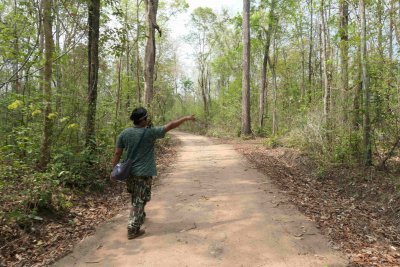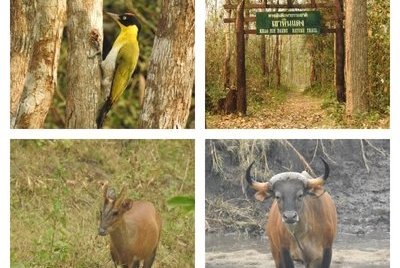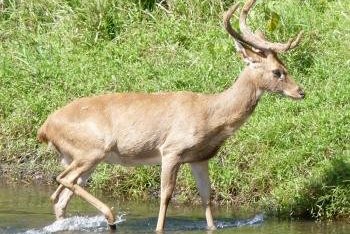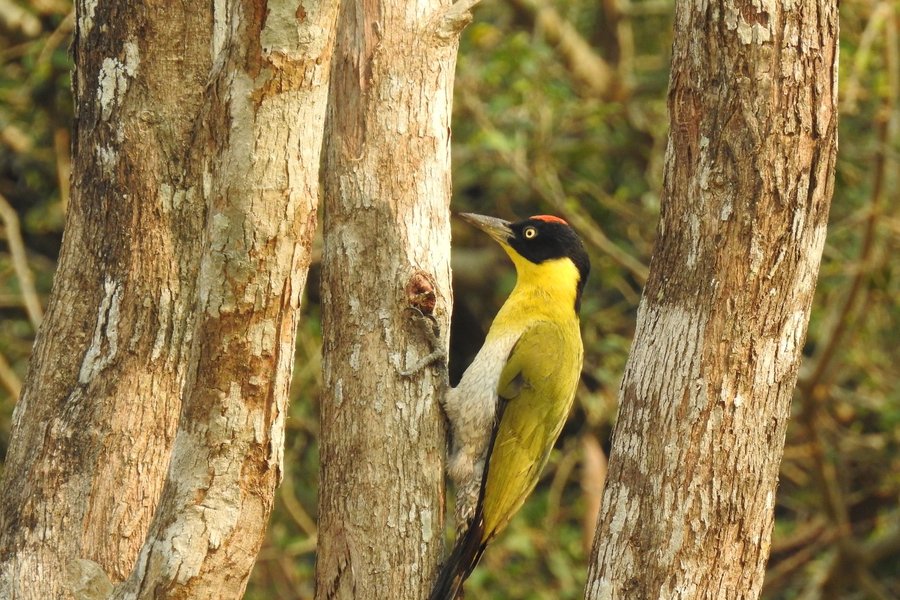Thailand
Thungyai-Huai Kha Khaeng
The Thungyai and Huai Kha Khaeng Wildlife Sanctuaries hold an unusual mix of species from four different biogeographic zones: Sundaic, Indo-Chinese, Indo-Burmese and Sino-Himalayan.
These two contiguous parks are located in the northwest of Thailand along the Burmese border. Thungyai is predominantly mountainous, with rivers and a central grassland plain. Huai Kha Khaeng is hilly and has five types of forests. The area is large and undisturbed enough to support the survival of elephants and tiger. The presence of mineral licks also is profitable for wildlife.
Community Perspective: a good excuse to visit Western Thailand, although getting into the inner core zone of the protected area is almost impossible and you are not allowed to stay overnight inside the park. Els describes a day visit with a park ranger to Huai Kha Khaeng Wildlife Reserve with good wildlife watching from one of its watchtowers, Solivagant entered the same area and explored it on his own, and Frederik enjoyed the surrounding areas of Tee Lor Su and Hoop Pa Taad Valley.
Site Info
Official Information
- Full Name
- Thungyai - Huai Kha Khaeng Wildlife Sanctuaries (ID: 591)
- Country
- Thailand
- Status
-
Inscribed 1991
Site history
History of Thungyai-Huai Kha Khaeng
- 1991: Inscribed
- Inscribed
- Type
- Natural
- Criteria
- vii
- ix
- x
Links
- UNESCO
- whc.unesco.org
- Official
-
- tourismthailand.org — Amazing Thailand: Thung Yai Naresuan Huai Kha Khaeng Wildlife Sanctuary
- Related
-
- cokesmithphototravel.com — Trip report: Four Days in Huai Kha Khaeng
- thainationalparks.com — Thai National Parks: Huai Kha Khaeng
All Links
UNESCO.org
- whc.unesco.org — whc.unesco.org/
Official Website
- tourismthailand.org — Amazing Thailand: Thung Yai Naresuan Huai Kha Khaeng Wildlife Sanctuary
Related Resources
- cokesmithphototravel.com — Trip report: Four Days in Huai Kha Khaeng
- thainationalparks.com — Thai National Parks: Huai Kha Khaeng
News Article
- March 20, 2019 iol.co.za — Thai millionaire who poached rare black leopard at heritage site faces jail
- Feb. 7, 2018 bangkokpost.com — Italian-Thai boss charged with hunting in sanctuary
Community Information
- Community Category
- Natural landscape: Forest
Travel Information
Recent Connections
-
Bears
Huai Kha Khaeng: Asian Black Bear and M…
-
Golden jackal
Huai Kha Khaeng (source)
-
Perfect Inscriptions
1991
Connections of Thungyai-Huai Kha Khaeng
- Geography
-
-
On National Border
Myanmar
-
- History
-
-
Famous suicides
Huai Kha Kheng - The suicide of Head Ranger "Seub Nakhasathien" as a cry for help from society and public authorities to seriously solve natural resources problems.
-
- Ecology
-
-
Golden jackal
Huai Kha Khaeng (source)
-
Rhino habitat
Sumatran rhinoceros -
Elephants
Asian elephant (Indian elephant) -
Otters
Smooth-coated Otter - nomination file -
Bovines
wild Indian water buffalo -
Critically endangered fauna species
Red-headed vulture (< 10,000 remaining) -
Strepsirrhini
slow loris -
Tapirs
Malayan tapir -
Preserved by notable Conservationists
Seub Nakhasathien (1948-90) “a Thai conservationist, environmental activist, and scholar who is renowned for his effort to protect Cheow Lan Lake…. Thungyai Naresuan Wildlife Sanctuary, and Huai Kha Khaeng Wildlife Sanctuary”. (Wiki)See en.wikipedia.org
-
Bears
Huai Kha Khaeng: Asian Black Bear and Malayan Sunbear (source)
-
Tiger habitat
HKK: "As of 2014 it still contained viable populations of large mammals, including gibbons, bears, elephants and Indochinese tigers," (wiki)
-
- Damaged
-
-
Poaching
Poaching remains one of the biggest threats, commercial trade for tiger, plus low-level substinence hunting -
Rangers killed by poachers
-
- World Heritage Process
-
-
Perfect Inscriptions
1991
-
- Human Activity
-
-
Natural sites with indigenous human population
Hmong villages in Thung Yai -
Indigenous groups expelled
Karen/Hmong. “The lead-up to the nomination had already seen a considerable amount of coerced resettlement of communities from both Huai Kha Khaeng and Thung Yai Naresuan. Karen villages in Huai Kha Khaeng had been removed in the 1970s when the Wildlife Sanctuary was established and when the Sri Nakarin Dam was built and later flooded their settlement areas. During the 1980s, most villages of the Hmong ethnic group were removed from the Huai Kha Khaeng and Thung Yai Naresuan wildlife sanctuaries” (WHS-IPR)
-
- WHS on Other Lists
-
-
World Heritage Forest Programme
-
Centres of Plant Diversity
EA59 Thung Yai-Huai Kha Khaeng Wildlife Sanctuary World Heritage Site - "Thung Yai-Huai Kha Khaeng Wildlife Sanctuary has exceptional species and habitat diversity. The property supports many wild plant and animal relatives of domestic species" -
Biodiversity hotspot
Indo-Burma, India and Myanmar
-
- Timeline
-
-
Holocene
The post-glacial, Holocene climate has created both the flora/fauna mix and the landscape.
-
- Visiting conditions
-
-
Foreigner prices
Locals 40B/Foreigners 400B
-
News
- iol.co.za 03/20/2019
- Thai millionaire who poached rare …
- bangkokpost.com 02/07/2018
- Italian-Thai boss charged with hun…
Recent Visitors
Visitors of Thungyai-Huai Kha Khaeng
- Atila Ege
- Bram de Bruin
- Dagmara
- Dimitar Krastev
- Els Slots
- Frederik Dawson
- henryjiao18
- Iain Jackson
- Joyce van Soest
- KarenBMoore
- Knut
- La Concy
- Luis Filipe Gaspar
- Michael Ayers
- Nihal Ege
- Olli-Pekka Turunen
- Roman Bruehwiler
- Solivagant
- SymonMajewski
- Szucs Tamas
- Thomas Buechler
- Timonator
- Vanessa Buechler
- Zoë Sheng
- Zos M
Community Reviews
Show full reviews
Basically I did the same visit as Els did, so I will not repeat most of it. However I took a different transport approach and had a different experience on site. That´s what I will describe below. I chose also the Huai Khai Khaeng wildlife sanctuary as Els´ review was very helpful and also on the website thailnationalparks.com you get good information on many of the countries parks including this one. I wanted to visit the site without rental car (self-drive) so I chose the closest city to the headquarters where the visitor area can be found. The website has a detailed map of the different trails and watch towers available there. My decision was the city of Nakhon Sawan which I reached after a 5 hour train ride from Bangkok- Bang Sue Junction station (46 THB). From the train station outside the 100k people city there are small pick-ups transporting passengers into the city center (12 THB). I stayed in the P A Hotel (450 THB per night) and the reception helped me arrange a taxi for the next day for a full day trip. First she was very pessimistic that anyone would drive that far, but then she found someone. The cost was at 2200 THB for the full day. It took us 2 hours to get to the headquarters (15.608595138194318, 99.320538667944) by car. Because we told our driver that we want to go to the memorial for the environmentalist Sueb Nakasatian he drove past the first control …
Keep reading 0 comments
As Huai Kha Khaeng is a forest reserve with a lot of ‘special’ mammals, a type of WHS that I usually enjoy, I had considered awarding extra time and money towards a visit. But, unfortunately, you still are not allowed to stay overnight inside the park. And I wasn’t going to pay 500-800 EUR for a 3-day tour that essentially meant going in and out every day just to sit in one of the watchtowers. So I am saving that money for Borneo later this trip in the hope of seeing an orangutan in the wild.
For my day visit to Huai Kha Khaeng Wildlife Reserve, I set out from the friendly and ultra-clean Numhom Resort near Thap Thang at 7.15 and arrived at the park gate just before the opening hour of 8.30. They sold me my tickets which had risen in price (for foreigners) to 400 baht per person and an additional 60 baht for the car. They also called ahead to the park headquarters (HQ) that 1 tourist was coming in!
It's another 9km drive to the main area, on a smooth unpaved road. I drove slowly with both windows open and the camera ready on the passenger seat, as it’s more of a safari drive and you never know what you will encounter. Nothing spectacular showed, but there were some colourful birds including a (mostly yellow and green) black-headed woodpecker.
The HQ almost feels like a military camp, with a stern guard (apparently …
Keep reading 0 comments
The first problem regarding our intended visit to Thungyai - Huai Kha Khaeng Wildlife Sanctuaries (HKK) was where exactly to enter this very large site, most of which is remote and inaccessible. The 2014 map on the UNESCO web site is described as a “Clarification”. It may indeed be better than the even worse one of 1990 but is pretty useless for identifying roads which go into the inscribed area or even for relating the park boundaries to those on other maps which did show roads such as Google or our paper “Reise Knowhow”! In the end I found this (and click on “Open Map”) which showed just 2 entry points to HKK from the East. These would seem to be the same as those referred to by Frederick Dawson in his review below. The northern entrance leading to the park HQ (marked “I”) on this map fitted in well with our general driving route from Mae Sot, through Khamphaeng Phet (part of Sukhothai WHS) and on south towards Ayutthaya, and also guaranteed that we would have entered the inscribed area. Whether it would provide “good” wildlife viewing only time would tell.!
We did consider whether to enter the Thung Yai element of the WHS (situated contiguous to HKK to its West) which may be more “scenic”. As Frederick also indicates, it does appear that official entry is possible from the North at the end of the 1090 road 50 kms south of Umphang. This road is described as “partly …
Keep reading 0 comments
I recently travelled into the WHS of Tung Yai via the enternace at Songapong (off the 323 Kanchanburi-Songklaburi road). The journey after the gate was 4wd drive only and then with a 32 inch whell clearance. We went as far as Kho Sadeng ranger station where we camped. To get there involved 18 river crossings in 15km. This jouney is impossible in all but the dry season, ask the locals!Largely evergreen mosit hill forest with Eleocarpus dominating the river banks. Many birds can be seen paricularly in vicinity of the river system. But we have touched only a small part of the sanctuary and intend to return again very soon ( Feb 2013)
Keep reading 0 comments
Huai Kha Khaeng is the most underrated WHS in Thailand. Why? This heritage place is not the tourist attraction! It is the eco study room and largest rain forest in Southeast Asia for everyone.
In the area of HQ comprises of office, staffs accommodation, canteen, campsite and exhibition building. They allow very limited area for visitors. There is a creek run through it and deer herds among the forest.
Thai people have known this place very well although a few have been there. Former head of the sanctuary committed suicide in his house in the HQ compound to save this forest from many causes ie dam development and so on.
His dedication have brought the consciousness of nature preservation to Thai society. So today Huai Kha Khaeng is saved from the greedy.
Keep reading 0 comments
For the country that tourism industry developed so well, it was quite surprised to discover that visiting Huai Kha Khaeng and Thung Yai were still almost unknown by tourist standard in Thailand even with the UNESCO World Heritage Site logo guaranteed. In 2009 with my friend, we traveled from Malaysia to Northern Thailand with stop enroute at the peaceful town of Uthaithani. We managed to hire local van to bring us to beautiful town of Lan Sak where the Huai Kha Khaeng's forest ranger HQ located.
At the office we pay 200 Thai Baht as the entry fee, here there were many trekking routes to see the forest to choose, the forest was OK with some bird, but there was no significant attraction. A ranger recommended us to visit Cyber Falls (very unusual name!) and Hoop Pa Taad Valley, so we continued our trip to the waterfall which located in other part of the Huai Kha Kheang about 40 minute drive from the HQ office, after 2 kms trekking and river crossing from the entrance, we reached the waterfall, the waterfall was quite lovely but nothing grand or spectacular, but compared to the trekking route at forest ranger HQ, the latter one was far better.
Then we went to Hoop Pa Taad Valley, not part of Huai Kha Khaeng but the adjacent buffer zone, but for us was the real highlight, the valley was located in the middle of limestone mount, we need to walk through the …
Keep reading 0 comments
I've been here last X'mas and stayed overnight.basically entering there but educational and scientific study and some eco tour that is managed by NGO especially burmese refugee suport organization.very beautiful place,if you're lucky,you could see wild peacock and tiger!in the rainy season rivers overflow with much rain.i recomend you wake up early and see fog sea from the mountain.
Keep reading 0 comments

